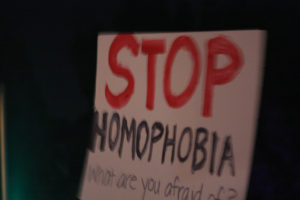
It’s been nine years since King and colleagues published their systematic review on mental disorders, suicide and self-harm in lesbian, gay and bisexual (LGB) people (King et al., 2008). Since then it has been cited 454 times, highlighting the interest and importance of the topic of the mental health of lesbian, gay, bisexual, transgender, queer and intersex (LGBTQI) people.
King et al’s review found a two-fold increase in risk of suicide attempts in LGB people compared with heterosexual people of all ages. Two further reviews of suicidality in sexual minority youth published in 2011 (Marshal et al., 2011) and 2015 (Ploderl & Tremblay, 2015) echoed these findings.
A new review and meta-analysis published in the British Journal of Psychiatry (Miranda-Mendizabal et al 2017) has updated this work by describing the risk of suicide attempt and suicide in LGB youth, while also seeking to identify specific risk factors for suicidality in this defined group.

What are the specific risks factors for suicidality in young LGB people?
Methods
- Studies were included if they were of longitudinal design, reported suicide or suicide attempt as an outcome, assessed at least one risk factor (including sexuality) for these outcomes, and sampled a population aged 12-26 years
- Suicidal ideation was excluded, as were studies of transgender and gender diverse (TGD) people, with the authors explaining that the latter was due to conceptual differences in sexual orientation and gender identity. Note that the term transsexual was used in the BJPsych review, as this is commonly used in the medical literature, but TGD would be regarded as the more inclusive term
- A broad range of six databases were searched, including grey literature and reference lists
- There were no restrictions on publication year or language.
This method aimed to improve on the 2011 Marshal et al review, and did this by including suicide as an outcome, identifying risk factors for suicidal behaviour, using a broader age range, and including papers up to June 2015.
The authors used Meta-analysis of Observational Studies in Epidemiology guidelines for systematic reviews, the Newcastle-Ottawa Scale for quality assessment of included studies, and random effects statistical models due to the degree of heterogeneity.
Results
They identified 14 articles. Quality of the studies was generally high, with little evidence of publication bias.
Prevalence
- Prevalence rates of suicide attempts ranged from:
- 6% to 70% in LGB youth
- 1.5% to 3.5% in heterosexual youth
- There was an increased risk of suicide attempts in gay and bisexual men compared to heterosexual men (OR=2.21, 95% CI 1.21 to 4.04)
- Lesbian or bisexual women were also at higher risk but this was not statistically significant, possibly due to the smaller numbers (OR=1.97, 95% CI 0.90 to 4.30)
Sexual orientation
- No conclusions could be drawn about sexual orientation and completed suicide as there were insufficient studies found to explore associations
- 8% (range 4-13) of suicide attempts could be attributed to sexual orientation
Risk factors for suicide attempt
- Only 4 studies investigated risk factors for suicide attempt, identifying the following six:
- Being open with families about sexual orientation
- Being called a ‘sissy’ or ‘tomboy’ by parents
- Parental psychological abuse
- Family history of depression and suicidality
- Childhood gender atypicality
- Past suicide attempt
- Among studies of risk factors, only findings relating to depression could be subjected to meta-analysis, but this was not found to be a risk factor for suicide attempt.

This review confirms what previous reviews have told us: young LGB people have a two-fold increase in risk of suicide attempts.
Strengths and limitations
The authors used rigorous methods to conduct the review and meta-analysis. Their findings were cautiously interpreted, and they rightly concluded by calling for more longitudinal studies to describe the role of putative mediators (such as victimisation, stigmatisation and discrimination), and to improve our understanding of the causal pathways between sexual orientation and suicidal behaviour.
We had two minor criticisms of the paper, and one wider concern about the focus of research in this field:
- Firstly, as the last search was conducted in June 2015, no papers published since then were included.
- Secondly we were concerned about their presentation of the population attributable risk (PAR) at face value. The authors stated that 8% of suicide attempts in adolescents and young adults could be attributed to LGB sexual orientation, but without qualifying what this means in practice. PAR estimates are of most use where the exposure or the mediators of risk are amenable to intervention (Rockhill et al, 1998). Misinterpretations are rife, and the authors failed to clarify that an ‘exposure’ like sexuality is an unmodifiable proxy for other exposures (such as psychological abuse). Stating that “sexual orientation is a major contributor to suicidal behaviour” does nothing to head off the risk that the lay press might go so far as to suggest changing one’s sexuality as a means of reducing suicide risk.
- Our main qualm with the review was the ‘so what?’ factor. Its findings of a two-fold increase in risk of suicide attempts in LGB young people are consistent with those of the previous Marshal et al (2011), King et al (2008) and Ploderl & Tremblay (2015) reviews. Through no fault of their own, the authors’ attempts to identify risk factors for suicidality in LGB young people yielded few studies. Their review therefore does little to advance our knowledge of suicidal behaviour in LGB adolescents beyond what King and colleagues reported almost a decade ago.
What their review does do, however, is highlight the imbalance of systematic reviews versus primary research on this topic. Our sense was that four systematic reviews within ten years have provided adequate evidence of an increased risk of suicide-related outcomes in LGB youth, and that we should now hold off on conducting further reviews and focus efforts on conducting primary research to find out why this risk is elevated. Without knowing why, it is unsurprising that Meader and Chan’s linked editorial (2017) identified the dearth of evidence on preventive strategies.

Listen up researchers! Now’s the time to conduct primary research investigating risk and protective factors for LGBTQI people in all age groups.
Possible explanations
The review’s authors use minority stress theory to explain the observed associations. This identifies the role of external stressors such as victimisation and discrimination or stigma, and internal stressors such as internalised homophobia. Most discourse on this topic has focussed on the impact of homophobic bullying in schools, yet this does not emerge from the review. The National Confidential Inquiry (PDF) report on suicide in young people found that a quarter of LGBT young people who had died by suicide had been bullied (NCISH, 2017). A recent survey of LGB young people in British schools found that 55% reported experiences of homophobic bullying in school; a fall of only 10% over 5 years (Guasp, 2017). This problem was largely unaddressed: 60% said that teachers who witness the bullying never intervene (Guasp, 2017). Meader and Chan’s linked editorial (2017) cites Canadian evidence that positive school environments (with policies prohibiting homophobia) are associated with a reduced risk of suicidal ideation and attempts (Saewyc et al, 2014). They suggest that services to address the specific needs of LGB young people might overcome barriers to help-seeking.
Social exclusion and humiliation are concepts at the centre of psychological theories of suicide (O’Connor et al, 2012), and it is easy to see how suicidality might arise in these marginalised youths. Yet home environments may be more toxic than schools. Crucially, Miranda-Mendizabal et al’s review identifies a neglected issue; that of parental attitudes. Three of the five risk factors they describe relate to family dynamics. As a recent BBC documentary on the experiences of lesbian, gay, transsexual and transgender (LGBT) adolescents reflected, parents sometimes struggle with their children’s sexuality. Parental homophobic attitudes clearly require further exploration, including qualitative work to determine what interventions are likely to be acceptable.

Parental homophobic attitudes clearly require further exploration, including qualitative work to determine what interventions are likely to be acceptable.
Conclusions
Practitioners remain in the dark about how best to address the problem of suicidality in LGB adolescents. This applies even more so to transgender and intersex youth, who are under-researched and may face particular problems of bullying due to their greater visibility as targets. Big data is not the answer, as the practice of sexual orientation monitoring is not widely embedded in routine data collection. We need to hit pause on conducting reviews and instead focus on primary research investigating risk and protective factors for LGBTQI people in all age groups. Only then can we work towards developing interventions to address modifiable risk factors, and progress towards reducing suicidal behaviour in LGBTQI people throughout the life course.
If you are experiencing suicidal thoughts or feelings
If you are experiencing suicidal thoughts or feelings, support is available from the following organisations:
Samaritans offer a 24 hours a day, 7 days a week support service. Call them FREE within the UK or the Republic of Ireland on 116 123.
If you live outside the UK or the Republic of Ireland, we recommend finding a local Crisis Centre on the IASP website
Links
Primary paper
Miranda-Mendizabal et al (2017) Sexual orientation and suicidal behaviour in adolescents and young adults: systematic review and meta-analysis. The British Journal of Psychiatry doi: 10.1192/bjp.bp.116.196345
Other references
Guasp A. (2017) The Schools Report: The experiences of gay young people in Britain’s schools in 2012 (PDF). Stonewall
King M, Semlyen J, Tai SS, et al. (2008) A systematic review of mental disorder, suicide, and deliberate self harm in lesbian, gay and bisexual people. BMC Psychiatry. 2008;8:70. doi:10.1186/1471-244X-8-70.
Marshal MP, Dietz LJ, Friedman MS, Stall R, Smith HA, McGinley J, Thoma BC, Murray PJ, D’Augelli AR, Brent DA. (2011) Suicidality and Depression Disparities Between Sexual Minority and Heterosexual Youth: A Meta-Analytic Review, Journal of Adolescent Health, Volume 49, Issue 2, 2011, Pages 115-123, ISSN 1054-139X, http://dx.doi.org/10.1016/j.jadohealth.2011.02.005.
Meader N, Chan M. (2017) Editorial: Sexual orientation and suicidal behaviour in young people. The British Journal of Psychiatry 211(2) DOI: 10.1192/bjp.bp.116.197475
National Confidential Inquiry into Suicide and Homicide by People with Mental Illness (NCISH). (2017) Suicide by children and young people. Manchester: University of Manchester, 2017
O’Connor R, Rasmussen S, Hawton K. (2012) Distinguishing adolescents who think about self-harm from those who engage in self-harm. BJPsych 200 (4) 330-335; DOI: 10.1192/bjp.bp.111.097808
Ploderl M, Tremblay P. (2015) Mental health of sexual minorities. A systematic review, International Review of Psychiatry, 27:5, 367-385, DOI:10.3109/09540261.2015.1083949 [PubMed abstract]
Rockhill B, Newman B, Weinberg C. (1998) Use and misuse of population attributable fractions. American Journal of Public Health. 88(1)15-19. http://ajph.aphapublications.org/doi/pdf/10.2105/AJPH.88.1.15
Saewyc EM, Konishi C, Rose HA, Homma Y. (2014) School-Based Strategies to Reduce Suicidal Ideation, Suicide Attempts, and Discrimination among Sexual Minority and Heterosexual Adolescents in Western Canada. International Journal of Child, Youth & Family Studies : IJCYFS, 5(1), 89–112.
Further reading
Lucassen MF, Stasiak K, Samra R, Frampton CM, Merry SN (2017) Sexual minority youth and depressive symptoms or depressive disorder: A systematic review and meta-analysis of population-based studies. Australian & New Zealand Journal of Psychiatry 51(8):774-787. http://journals.sagepub.com/doi/full/10.1177/0004867417713664
Joiner TE, Van Orden KA, Witte TK, et al. (2009) Main Predictions of the Interpersonal-Psychological Theory of Suicidal Behavior: Empirical Tests in Two Samples of Young Adults. Journal of Abnormal Psychology. 118(3):634-646. doi:10.1037/a0016500. https://www.ncbi.nlm.nih.gov/pmc/articles/PMC2846517/
Related resources
BBC Three documentary: Growing up gay http://www.bbc.co.uk/programmes/p057nfy7
Photo credits
- SmartPhotoCourses
- John Nakamura Remy CC BY 2.0
- wilson.corral CC BY 2.0
- Photo by Dmitri Popov on Unsplash
- Photo by Levi Saunders on Unsplash

[…] I would like to reiterate the comments of Pitman and Rowe (2017) in an earlier Mental Elf blog which called for a “pause on conducting reviews and…–focus on primary research”. Such […]